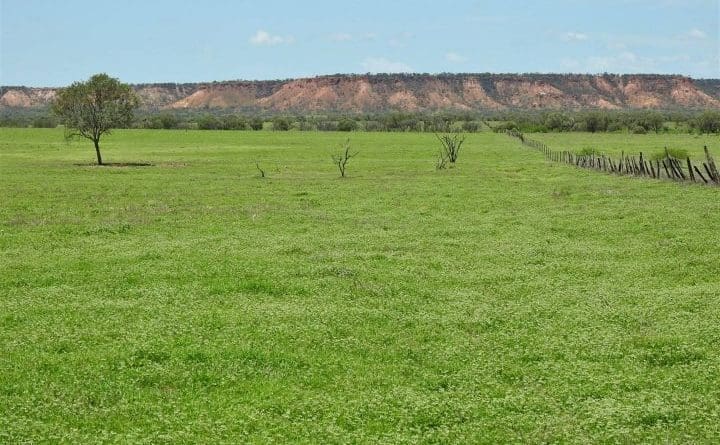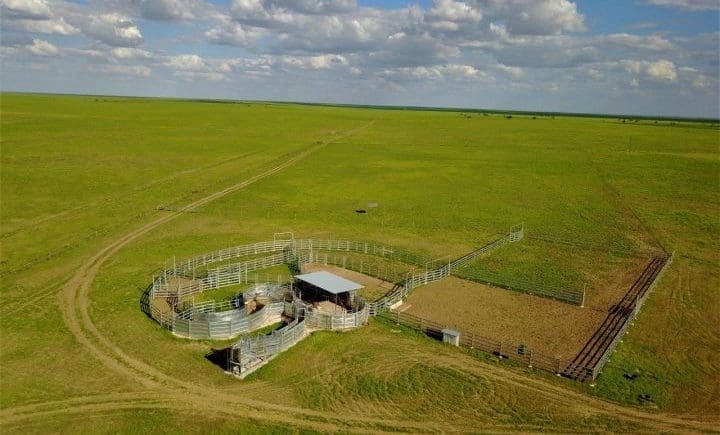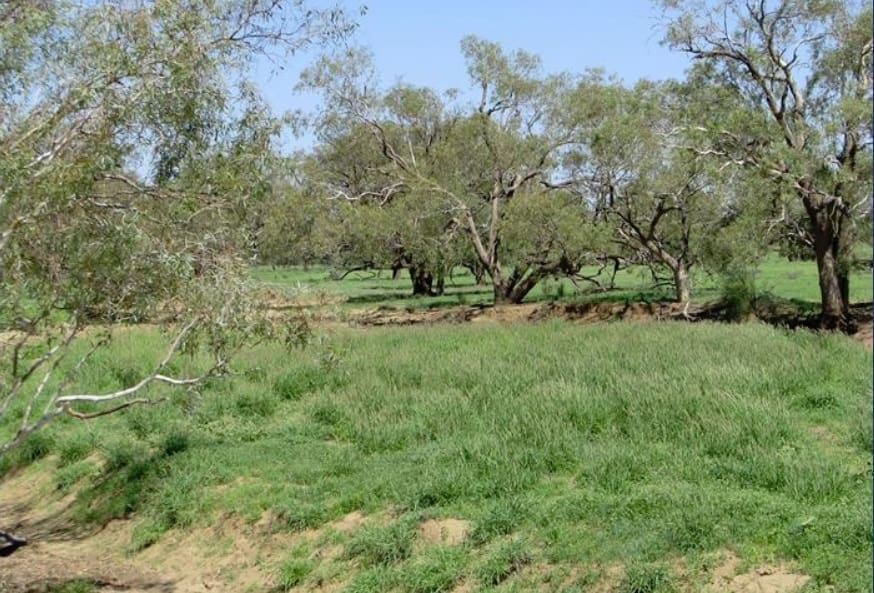
Suvla, 18,500ha north of Winton, already has an abundance of short green feed after February rain
A MINI property boom is unfolding in northwest and central western Queensland where beneficial rains fell last month.
With green feed returning to paddocks across the region (see image above), a window of opportunity has emerged to market grassed-up properties to cattle producers further south, and across the Northern Territory border, who remain in the depths of a brutal drought.
Beef Central has identified at least a dozen holdings in the north/central west of the state, and as far east as Charters Towers, where big February falls were received, which have hit the market over the past fortnight. All are using a body of green feed, or at least the early signs of it, as the key selling point.
Some of the properties (see examples below) are new to the market, with vendors electing to seize the opportunity that has just emerged; while others have been on the market (in some cases, passively) for two or three years or more. They are now being re-marketed with greater vigour since the arrival of green feed.
Most of the properties coming to market are on the fringes of the severely flood-affected region further north and west, but which received good falls of 100-300mm in February – in some cases on top of chance storms in December/January.
‘Grass fever’
So-called ‘grass fever’ has attracted buyer interest to the region from across a vast expanse of eastern Australia over the past week.
Feedback from property agents in the region suggest that buyer interest is coming from an incredibly wide area – Northern Territory cattle producers, Blackall/Longreach areas where rain did not fall, across Central Queensland down as far as Moura, Springsure and Rolleston; across the Maranoa region surrounding Roma; the Charleville/Cunnamulla region in Queensland’s southwest; and from across large parts of New South Wales.
Local agents have been kept busy with inspections over the past week, with a lot more to come.
“Because they were either lightly stocked or destocked due to the previous dry, some of this country has come away pretty well, given the warm weather,” Ruralco agent Peter McPherson said.
“Any property owner in the rain-impacted region in a mood to sell, is seeing this as an opportunity. If there was more widespread rain across Queensland now, a lot more country would come on, too,” he said.
Herron Todd White’s rural national director Tim Lane told Beef Central he thought the industry would be surprised over the next four to six months over just how many property transactions of this type take place.
“Any grazing property with grass that comes to market – which most of the country does not have – is guaranteed to attract interest,” Mr Lane said.
“Demand is coming from everywhere – either seeking agistment or to purchase grassed properties outright,” he said.
“It’s happening from the corporate scale right back to the significant individual and through to family-scale buyers. There’s a lot of people out there with cheque books open. Some are actively seeking-out owners who may wish to sell up, given some prompting, rather than waiting until properties come to market.”
“The agency industry is going to be very busy in the region, for the next few months,” Mr Lane said.
“The majority of interest is just about buying grass, and holding their breeding herds together, with a view to perhaps sell out again in two or three years’ time when normal seasons return further south. Even if they now get rain down south, they will need to let that country rest-up and regenerate first.”
“Some of the stories we are hearing are that intending buyers might even be prepared to take a capital loss when re-selling in a few years’ time, just to get them out of trouble. Whether that becomes the reality or not remains to be seen,” Mr Lane said.
He said similar episodes of buying country for grass were not unprecedented, and had happened several times during the 1980s and 1990s when one part of the country was desperately dry, while another enjoyed favourable conditions.
“It happened as recently as a couple of years ago. The cost of feed is the other big driver. Cotton seed and roughages are now either acutely expensive or unprocurable, and after feeding cattle so long, property purchase starts to look like an attractive option to hold those stock. It’s that maths exercise between trying to feed and hold, versus land purchase which is now being done,” Mr Lane said.
“People in the wet areas of the north are trying all sorts of things to take advantage of the soil moisture conditions. Some are trying aerially-seeding sorghum onto grazing paddocks (not cultivation), to try to further boost the feed bank this year.”
Winton stock and station agent Tom Brodie said he had activated seven listings since last month’s rain event, all being driven by new green feed.
Most are open downs Mitchell/Flinders grass properties, but also include some spinifex-type country north of Muttaburra.
“Some people on the fringe of the flood damage area are trying to capitalise on the grass that they are seeing, and see this as a sale opportunity,” Mr Brodie said.
Some of these vendors were ‘retirement age’ – people who had been looking to wind-up for a while but who had been held-up by the sequence of dry years – while others were winding up family partnerships, or deciding to sell for other reasons.
“They all just want to make use of the opportunity,” Mr Brodie said.
While the current property market momentum had only just really started, he said he knew of two local properties that had already gone under contract.
“Both got the money they asked for, having been on the market (passively) for about four to five years, through the dry period.”
Recent listings offered for grass
Here’s a quick summary of some of the recent listings in the north and northwest of Queensland to hit the market:
Suvla, 18,500ha located about 80km southwest of Winton (pictured above), is listed by Brodie Agencies. Mostly open downs with valley and channel country, Suvla received about 325mm of rain during the February rain event. It goes to auction on 11 April if not sold beforehand.
Mutti, 30,600ha near Jundah, is also listed by Brodie Agencies. Predominately sweet pebbly downs country lightly interspersed with scattered gidgee and boree, Mutti is and outstanding finishing block. It is being offered for $3.5 million bare, with some early access. It received between 75mm and 100mm in February.
Brodie Agencies has another couple of properties listed in the Winton/Corfield area, on the edge of the big rain that fell. They include Pauralos Park, 10,200ha of Mitchell/Flinder grass country northwest of Longreach (pictured below). It received 50-75 mm of rain in October/November and had great follow up rain of 187mm in February.

Pauralos Park received 50-75 mm of rain in November and had great follow up rain of 187mm in February.
Also west of Longreach is Marmboo – 39,00ha of open downs country, being offered through Ruralco’s Peter McPherson. It received 160mm in February, all beneficial rain without flooding, after earlier December storms. The property was already destocked after earlier drought, meaning the country is getting a good spell after rain. Mr McPherson said the vendors were basically selling for grass, having seen a marketing window of opportunity after the fortunate rain. “The marketing campaign did not start until this week, but we already received a number of calls last week, just through word of mouth,” he said. “Early inquiry can from as far as Thallon, Roma and Mitchell.”
Next door to Marmboo, Colliers International has listed 13,000ha Colanya, 90km northwest from Longreach. Mostly open downs Mitchell/Flinders grass with buffel in creeks, Colanya received 250mm in February, on top of decent falls pre-Christmas. No stock are currently run on the property, meaning it has had a good chance to come away.
“The vendors wanted to sell previously, so the rain has provided the added catalyst,” marketing agent Ben Forrest said. “Its due to go to auction on 3 April, but we think there is a good chance it will sell prior to auction day. There’s just so much drought around that a bit of grass will go a long way,” he said. Early inquiry had come from right across Queensland, and the marketing campaign has only just started.
Mr Forrest said while most interest was coming from producers further south who were ‘just sick of supplementary feeding cattle and wanting to shift stock onto grass, there might also be some opportunists looking to make a purchase of a grassed property in the north and go into the market to buy (currently cheap) stock to fill it. “People will be doing the sums,” he said.

Buffel grass in abundance in creeks on Colanya northwest of Longreach
On the Thompson River flood-out country near Stonehenge, Wally Cooper from Rural Property & Livestock has listed Depot Glen, an ideal backgrounding and fattening block covering some 12,000ha including stock route. Country is already starting to come away after February rain.
Newly-sprouted grass is also a key selling point for Julia Creek grazing property Wivenoe, recently placed on the market through Peter Dowling at Dowling Livestock & Property. Located east of Julia Creek, Wivenhoe is a little over 11,700ha of quality downs fattening or breeding country in tick-free area, offering low cost good grass and reliable water. Showing a good response to recent rainfall, the vendors estimate a long-term average stocking rate of 1200 adult equivalents.
North of Aramac, 30,100ha breeding and fattening property Caledonia has also been placed on the market, via expressions of interest through Slaney & Co, Charters Towers. A good body of buffel grass is evident after earlier rain.
Outside the immediate northwest region, but facing a similar situation following torrential rain in February is Hillsborough, a coast hinterland grazing property near Ravenswood, not far from Charters Towers. The 42,600ha has a good body of feed after February rain, agent Peter McPherson from Ruralco says.
How much will buyers pay?
What’s yet to be determined since the grass-fever market emerged in the northwest in the past fortnight is what premium, if any, buyers will be prepared to pay for country with grass, at a time when it is a scarce commodity indeed.
Its known that asking prices on some recently listed places have been lifted in the past week, as vendor expectations over ‘grass fever’ among buyers has grown.
Some agents have advised parties interested in securing country with feed to have finance organised before making inspections. That’s because, in a classic ‘feeding frenzy’ situation, there’s a risk that by asking for a finance clause for three weeks grace, the vendor may just keep taking inspections until a contract goes unconditional, Beef Central was told.
Given the circumstances, some vendors may also have unrealistic expectations over price, several agents said.
“Some may get 10 percent above what they were trying to sell the same property for last year, but they need to be careful they don’t get too greedy. Already some interested parties from further south have said they will now sit on the sidelines until the heat goes out of the market again,” one contact said.
- See tonight’s separate weekly property review, which also focuses on the rapidly changing makret in Northwest QLD.

Excellent, well-researched report…
are the people who are now outlaying big $$ for grassed up properties and outlaying $10000 for bulls at Brahman sales and spending weekends at campdrafts the same ones with hands out for charity support……as an industry we sure do present a mixed message
Many would argue that paying $10,000 for a high-EBV bull at a bull sale is a shrewd investment in the future, David – hardly an indulgence. Editor